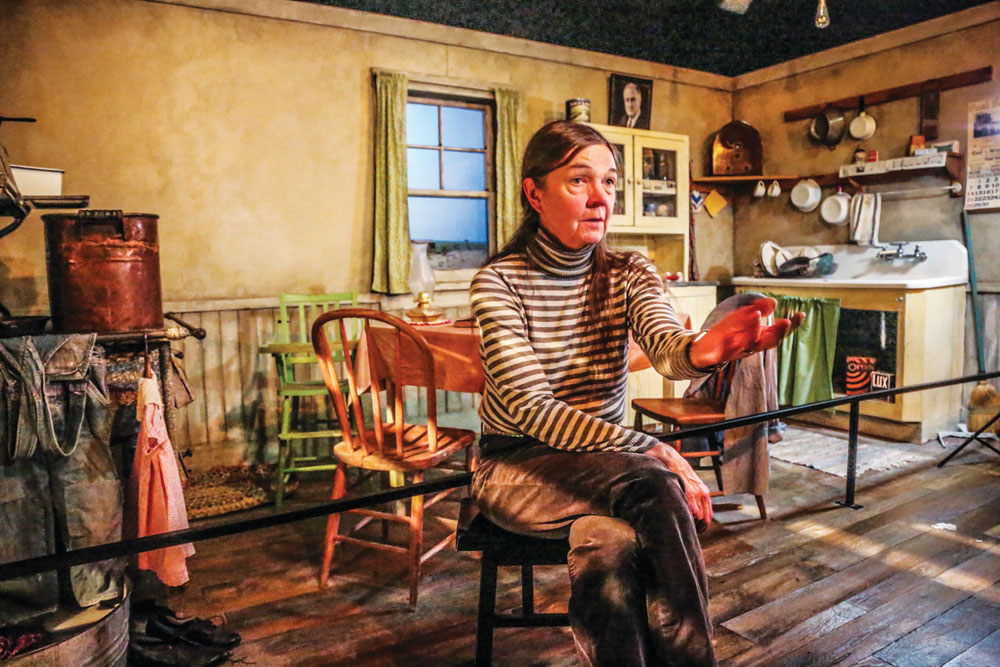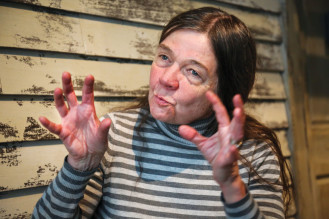
Patty Limerick sits in the Dust Bowl exhibit at the Colorado History Center. In her role as Colorado State Historian, she will help decide new exhibits for the museum.
Author, lecturer and history buff, Patty Limerick has been appointed the new Colorado State Historian.
Limerick has been known for her colorful, straightforward accounts of the West. She serves as faculty director and chair of the board of the Center of the American West at the University of Colorado (CU) at Boulder.
Limerick will continue her duties at CU in a new partnership between the university and History Colorado, a historical society that offers public access to cultural and heritage resources of Colorado, including the History Colorado Center downtown.
What is the role of the state historian?
The role has two principle elements. One is what I’ve always tried to be—the cheerleader, the advocate, the persistent person calling attention to the value of history and how we got to this point in time …. It’s really not a good idea for humanity to be bumbling around in a state of amnesia about the past.
Then, I get to play a central role in choosing topics for exhibits, programs, putting forward what I know about the academic world, and figuring out how to be engaged in the best way that helps citizens be knowledgeable and know why it’s special to be in Colorado.
Do you have sole control over the content of the museum?
The answer should not be frozen or static, but dynamic and we’re always working out chains of communications … I bring historical expertise and experience, but I am not a solo actor with hammers and screws and can make an exhibit case on my own.

Limerick is passionate about The West and sharing its history with Coloradans.
What are some of the challenges of putting together an exhibit?
There are challenges of taking one story within a complicated history. How do you put into a museum a place that was dusty and hard to live in when there will be kids visiting the museum? But you don’t want it to look inaccurate. We will be thinking about a lot of those questions and how can we, in the limited space of a museum, convey complexity and how groups’ histories don’t stay separate.
So, one thing I have to admit is every time I visit History Colorado Center there are not many people there. Is that something you have focused on or discussed?
I think that’s on everyone’s radars. I think the partnerships with Denver Art Museum and Denver Museum of Nature & Science will be helpful. We want to make the atrium much more of a community space where people can have lunch or take part in whatever events we have. The location of History Colorado Center is so central we need to find what will magnetize people. Huge opportunity.
What is your favorite museum or exhibit you’ve ever been to?
Well, there’s an interesting question. I would say the 150th anniversary of the California Gold Rush at the Oakland Museum was really good—visually compelling, sophisticated and really up-to-date with academic understanding, and so immediate in the humor reality of it. And it showed the long-term impacts of the Gold Rush.
Also, the Park City, Utah, museum uses technology in a really interesting way. When you’re leaving, there’s a big, old-fashioned bar with a mirror behind the bar. And projected on the screen are old-timers telling stories. It’s everything you want when you visit an old town and the locals tell you stories.
I’m curious about your opinion of the controversy whether to change Stapleton’s name because of the affiliation with KKK member Ben Stapleton.
I do have a lot of thoughts about that … I feel we, as a society, sometimes it makes sense to keep the name and reckon with the history. And sometimes the reckoning with the history distracts us from living productively with the history … Stapleton is a great example of how we can exercise our thinking around that. The name Stapleton will never be erased from Colorado history. We shouldn’t even contemplate that. Meanwhile, the Stapleton development is really a distinctive concept of new urbanism that’s not directly tied to Mayor Stapleton’s vision when it was an airport …. To say, well, we have to keep every aspect of the past, including a name that doesn’t connect to what’s happening there now, maybe it is time for a new name. Whatever it is, it is an occasion for excellent, productive, grounded deliberation on history and how we live with it.
The History Colorado Center is located at 1200 Broadway. For more information call 303.447.8679 or visit www.historycolorado.org/museums/history-colorado-center




0 Comments